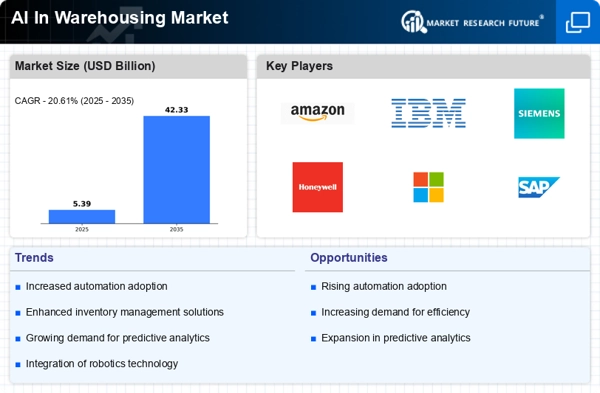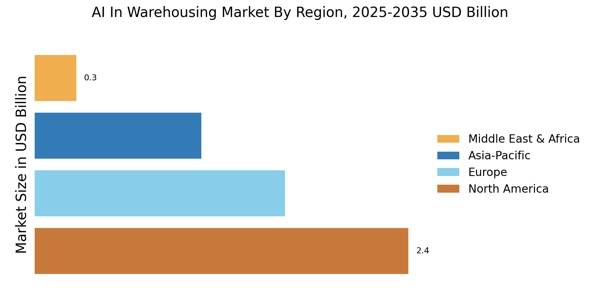Advancements in Robotics
The AI In Warehousing Market is significantly influenced by advancements in robotics technology. The integration of AI with robotics enables the automation of various warehousing tasks, such as picking, packing, and sorting. Recent data indicates that the use of AI-driven robots can reduce operational costs by up to 25%, while also minimizing human error. As robotics technology continues to evolve, the capabilities of these machines expand, allowing for more complex tasks to be automated. This trend not only enhances productivity but also addresses labor shortages in the warehousing sector. Consequently, the growing reliance on robotics in warehousing operations is likely to drive the expansion of the AI In Warehousing Market in the coming years.
Growing E-commerce Sector
The AI In Warehousing Market is being propelled by the rapid growth of the e-commerce sector. As online shopping continues to gain popularity, the demand for efficient warehousing solutions has intensified. E-commerce companies are increasingly adopting AI technologies to optimize their warehousing operations, ensuring timely order fulfillment and effective inventory management. Recent statistics indicate that the e-commerce market is projected to grow at a compound annual growth rate of over 15% in the next few years, further driving the need for advanced warehousing solutions. This trend suggests that the AI In Warehousing Market will benefit from the increasing reliance on technology to meet the demands of a dynamic e-commerce landscape.
Rising Demand for Efficiency
The AI In Warehousing Market is experiencing a notable surge in demand for operational efficiency. Companies are increasingly adopting AI technologies to streamline their warehousing processes, thereby reducing labor costs and enhancing productivity. According to recent estimates, the integration of AI can lead to a 20-30% increase in efficiency in warehouse operations. This trend is driven by the need for faster order fulfillment and improved inventory management. As businesses strive to meet consumer expectations for rapid delivery, the implementation of AI solutions becomes essential. Furthermore, the competitive landscape compels organizations to leverage AI to maintain a competitive edge, suggesting that the demand for efficiency will continue to propel growth in the AI In Warehousing Market.
Emphasis on Supply Chain Resilience
The AI In Warehousing Market is also influenced by the growing emphasis on supply chain resilience. Organizations are increasingly recognizing the importance of robust supply chains that can withstand disruptions. AI technologies play a crucial role in enhancing supply chain visibility and agility, allowing businesses to respond swiftly to changes in demand and supply. Data indicates that companies implementing AI solutions in their supply chains can improve their responsiveness by up to 30%. This focus on resilience is likely to drive investments in AI technologies within the warehousing sector, as firms seek to build more adaptable and efficient operations. Consequently, the AI In Warehousing Market is expected to experience sustained growth as businesses prioritize resilience in their supply chain strategies.
Increased Focus on Data-Driven Decision Making
The AI In Warehousing Market is witnessing a shift towards data-driven decision making, as organizations recognize the value of leveraging data analytics. AI technologies facilitate the collection and analysis of vast amounts of data, enabling businesses to make informed decisions regarding inventory management, demand forecasting, and supply chain optimization. Reports suggest that companies utilizing AI for data analytics can achieve a 15-20% reduction in excess inventory, leading to significant cost savings. This emphasis on data-driven strategies is likely to enhance operational efficiency and responsiveness to market changes, thereby fostering growth in the AI In Warehousing Market. As firms increasingly prioritize data analytics, the demand for AI solutions in warehousing is expected to rise.


















Leave a Comment